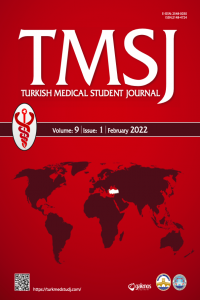CERVICAL MENINGOCELE IN A NEWBORN: A CASE REPORT
CERVICAL MENINGOCELE IN A NEWBORN: A CASE REPORT
Meningocele cervical meningocele, neurosurgery, neural tube defects,
___
- 1. Greene ND, Copp AJ. Neural tube defects. Annu Rev Neurosci 2014;37:221-42.
- 2. Lemire RJ. Neural tube defects. JAMA. 1988 Jan 22-29;259(4):558- 62.
- 3. Hynd GW, Morgan AE, Vaughn M. Neurodevelopmental malfor- mations: etiology and clinical manifestations. In: Reynolds CR, Flet- cher-Janzen E, editors. Handbook of clinical child neuropsychology. 3rd ed. New-York: Springer; 2009.p.147-68.
- 4. Nussbaum RL, McInnes RR, Willard HF. Risk assessment and ge- netic counseling. In: thompson & thompson genetics in medicine. 8th ed. Philadelphia: Elsevier; 2016.p.333-48.
- 5. Gupta N, Ross ME. Disorders of neural tube development. In: Swa- iman KF, Ashwal S, Ferriero DM et al. Swaimans pediatric neurology: principles and practice. Edinburgh: Elsevier; 2018.p.437-58.
- 6. Sun JCL, Steinbok P, Cochrane DD. Cervical myelocystoceles and meningoceles: long-term follow-up. Pediatric Neurosurgery 2000;33(3):118–22.
- 7. Huang SB, Dohery D, Congenital malformations of the central nervous system. In: Gleason CA, Juul SE, editors. Averys diseases of the newborn. Philadelphia, PA: Elsevier; 2018.p.877
- 8. Denaro L, Padoan A, Manara R et al. Cervical myelomeningocele in adulthood. Neurosurgery 2008;62(5)1169-71.
- 9. Delashaw JB, Park TS, Cail WM et al. (1987). Cervical menin- gocele and associated spinal anomalies. Child's Nervous System 1987;3(3):165–9.
- 10. Salih MA, Murshid WR, Seidahmed MZ. Epidemiology, prena- tal management, and prevention of neural tube defects. Saudi Med J. 2014 Dec;35 Suppl 1(Suppl 1):S15-28.
- 11. Sahni M, Ohri A. Meningomyelocele. In: StatPearls. Treasure Is- land (FL): StatPearls Publishing; 2020. Available from: URL: https:// www.ncbi.nlm.nih.gov/books/NBK536959/.
- 12. Erşahin Y, Barçin E, Mutluer S. Is meningocele really an isolated lesion. Child's Nerv Syst 2001;17(8):487–90.
- 13. Levene MI, Chervenak FA. Surgical management of neural tube defects. In: Fetal and neonatal neurology and neurosurgery. 4th ed. Churchill Livingstone; 2008.p.851
- 14. Öncel MY, Özdemir R, Kahilogulları G et al. The effect of surgery time on prognosis in newborns with meningomyelocele. J Korean Neurosurg Soc 2012;51(6):359-62.
- 15. Konya D, Dagcinar A, Akakin A et al. Cervical meningocele ca- using symptoms in adulthood. Journal of Spinal Disorders & Tech- niques. 2006;19(7):531–3.
- ISSN: 2148-4724
- Başlangıç: 2014
- Yayıncı: Trakya Üniversitesi
THOUGHTS AND AWARENESS OF MEDICAL STUDENTS ABOUT THE COVID-19 PANDEMIC
Hilal Sena ÇİFCİBAŞI, Alperen ELİBOL, Berkay KEF, Bengisu GÜR, Selin KOLSUZ, Berra KURTOĞLU, Hasan Orkun İPSALALI, Nazlıcan KÜKÜRTCÜ, Ece ŞENYİĞİT, Ekin ALTINBAŞ, Berfin TAN, Aslı GÖZTEPE, Alperen Taha CERTEL, Arda Ulaş MUTLU, Burak BARDAKÇI, Elif CENGİZ, Nigar KELEŞ ÇELİK, Can ERZİK, Mehmet Ziya DO
Arda Ulaş MUTLU, Bilgesu AYDIN, Özge ECERTAŞTAN, Eren ÖĞÜT, Bilge GÜVENÇ TUNA, Hakan TUNA
POSSIBLE BENEFICIAL EFFECTS OF VITAMIN K AND OSTEOCALCIN ON GLUCOSE METABOLISM
Büşra BAŞPINAR, Nurcan YABANCI AYHAN
CERVICAL MENINGOCELE IN A NEWBORN: A CASE REPORT
Eylül ŞENÖDEYİCİ, Ahmet Tolgay AKINCI, Yener AKTÜRK
ASSESSMENT OF THE OPINIONS AND ATTITUDES OF MEDICAL STUDENTS TOWARDS LGBTQIA+ INDIVIDUALS
Fatih Erkan AKAY, Beliz KOÇYİĞİT, Amila KAFADAR, Beril AY, Kaan ÇİFCİBAŞI, Çağrı GİRİT, Nazlıcan KÜKÜRTCÜ, Berra KURTOĞLU, Bengisu GÜR, Serdar ÖZTRORA
KNOWLEDGE LEVEL OF MEDICAL, PHARMACY AND NURSING STUDENTS ABOUT VACCINATION AND VACCINE SAFETY
Ertuğrul KOÇAK, Aynur Sanem YILMAZ, Bilge Nur MUTLU, Fatma KAYNAK ONURDAĞ
CORONAVIRUS DISEASE-19 (COVID-19): THE DISEASE THAT CHANGED THE WORLD
Beliz KOÇYİĞİT, Sezin SAYIN, Fevzi Oktay ŞİŞMAN, Sarper KIZILKAYA, Mert Yücel AYRIK
